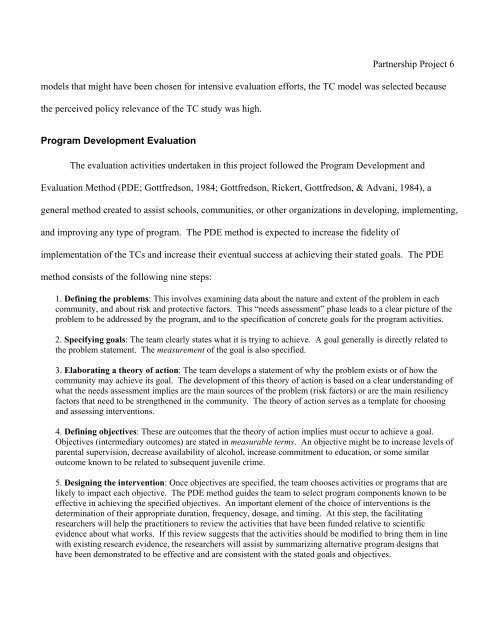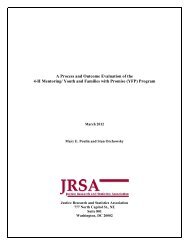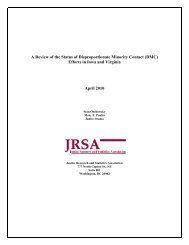This report provides an analysis of the XXX County Teen Court ...
This report provides an analysis of the XXX County Teen Court ...
This report provides an analysis of the XXX County Teen Court ...
You also want an ePaper? Increase the reach of your titles
YUMPU automatically turns print PDFs into web optimized ePapers that Google loves.
Partnership Project 6<br />
models that might have been chosen for intensive evaluation efforts, <strong>the</strong> TC model was selected because<br />
<strong>the</strong> perceived policy relev<strong>an</strong>ce <strong>of</strong> <strong>the</strong> TC study was high.<br />
Program Development Evaluation<br />
The evaluation activities undertaken in this project followed <strong>the</strong> Program Development <strong>an</strong>d<br />
Evaluation Method (PDE; Gottfredson, 1984; Gottfredson, Rickert, Gottfredson, & Adv<strong>an</strong>i, 1984), a<br />
general method created to assist schools, communities, or o<strong>the</strong>r org<strong>an</strong>izations in developing, implementing,<br />
<strong>an</strong>d improving <strong>an</strong>y type <strong>of</strong> program. The PDE method is expected to increase <strong>the</strong> fidelity <strong>of</strong><br />
implementation <strong>of</strong> <strong>the</strong> TCs <strong>an</strong>d increase <strong>the</strong>ir eventual success at achieving <strong>the</strong>ir stated goals. The PDE<br />
method consists <strong>of</strong> <strong>the</strong> following nine steps:<br />
1. Defining <strong>the</strong> problems: <strong>This</strong> involves examining data about <strong>the</strong> nature <strong>an</strong>d extent <strong>of</strong> <strong>the</strong> problem in each<br />
community, <strong>an</strong>d about risk <strong>an</strong>d protective factors. <strong>This</strong> “needs assessment” phase leads to a clear picture <strong>of</strong> <strong>the</strong><br />
problem to be addressed by <strong>the</strong> program, <strong>an</strong>d to <strong>the</strong> specification <strong>of</strong> concrete goals for <strong>the</strong> program activities.<br />
2. Specifying goals: The team clearly states what it is trying to achieve. A goal generally is directly related to<br />
<strong>the</strong> problem statement. The measurement <strong>of</strong> <strong>the</strong> goal is also specified.<br />
3. Elaborating a <strong>the</strong>ory <strong>of</strong> action: The team develops a statement <strong>of</strong> why <strong>the</strong> problem exists or <strong>of</strong> how <strong>the</strong><br />
community may achieve its goal. The development <strong>of</strong> this <strong>the</strong>ory <strong>of</strong> action is based on a clear underst<strong>an</strong>ding <strong>of</strong><br />
what <strong>the</strong> needs assessment implies are <strong>the</strong> main sources <strong>of</strong> <strong>the</strong> problem (risk factors) or are <strong>the</strong> main resiliency<br />
factors that need to be streng<strong>the</strong>ned in <strong>the</strong> community. The <strong>the</strong>ory <strong>of</strong> action serves as a template for choosing<br />
<strong>an</strong>d assessing interventions.<br />
4. Defining objectives: These are outcomes that <strong>the</strong> <strong>the</strong>ory <strong>of</strong> action implies must occur to achieve a goal.<br />
Objectives (intermediary outcomes) are stated in measurable terms. An objective might be to increase levels <strong>of</strong><br />
parental supervision, decrease availability <strong>of</strong> alcohol, increase commitment to education, or some similar<br />
outcome known to be related to subsequent juvenile crime.<br />
5. Designing <strong>the</strong> intervention: Once objectives are specified, <strong>the</strong> team chooses activities or programs that are<br />
likely to impact each objective. The PDE method guides <strong>the</strong> team to select program components known to be<br />
effective in achieving <strong>the</strong> specified objectives. An import<strong>an</strong>t element <strong>of</strong> <strong>the</strong> choice <strong>of</strong> interventions is <strong>the</strong><br />
determination <strong>of</strong> <strong>the</strong>ir appropriate duration, frequency, dosage, <strong>an</strong>d timing. At this step, <strong>the</strong> facilitating<br />
researchers will help <strong>the</strong> practitioners to review <strong>the</strong> activities that have been funded relative to scientific<br />
evidence about what works. If this review suggests that <strong>the</strong> activities should be modified to bring <strong>the</strong>m in line<br />
with existing research evidence, <strong>the</strong> researchers will assist by summarizing alternative program designs that<br />
have been demonstrated to be effective <strong>an</strong>d are consistent with <strong>the</strong> stated goals <strong>an</strong>d objectives.
















